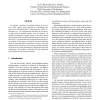1137 search results - page 39 / 228 » A study of slipstream processors |
ARCS
2004
Springer
14 years 1 months ago
2004
Springer
: Today’s network processor utilize parallel processing in order to cope with the traffic growth and wire-speed of current and future network technologies. In this paper, we stu...
HPDC
2000
IEEE
14 years 19 hour ago
2000
IEEE
Current processor allocation techniques for highly parallel systems are based on centralized front-end based algorithms. As a result, the applied strategies are restricted to stat...
IPPS
2003
IEEE
14 years 27 days ago
2003
IEEE
In systems consisting of multiple clusters of processors which employ space sharing for scheduling jobs, such as our Distributed ASCI1 Supercomputer (DAS), coallocation, i.e., the...
IPPS
2007
IEEE
14 years 1 months ago
2007
IEEE
Network processors today consists of multiple parallel processors (microengines) with support for multiple threads to exploit packet level parallelism inherent in network workload...
APPROX
2004
Springer
14 years 1 months ago
2004
Springer
We study the problem of minimizing the broadcast time for a set of processors in a cluster, where processor has transmission time , which is the time taken to send a message to any...

